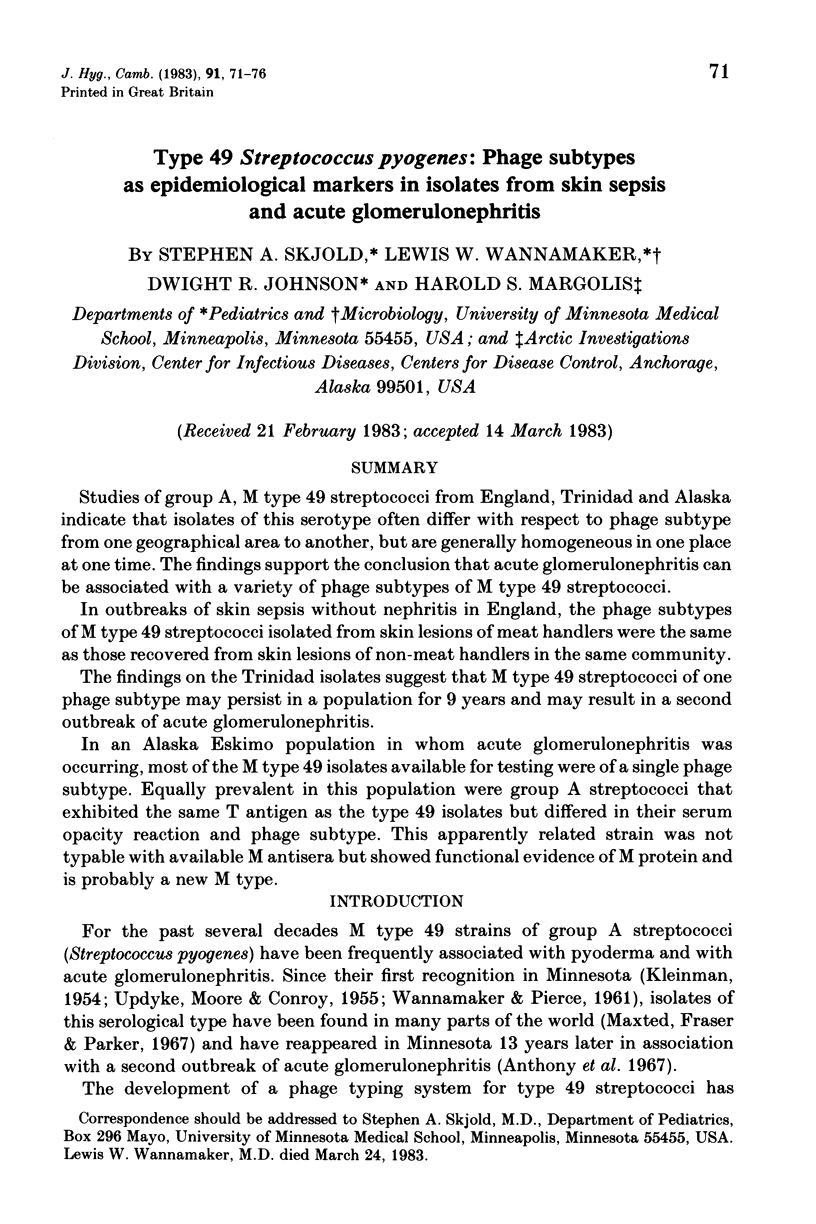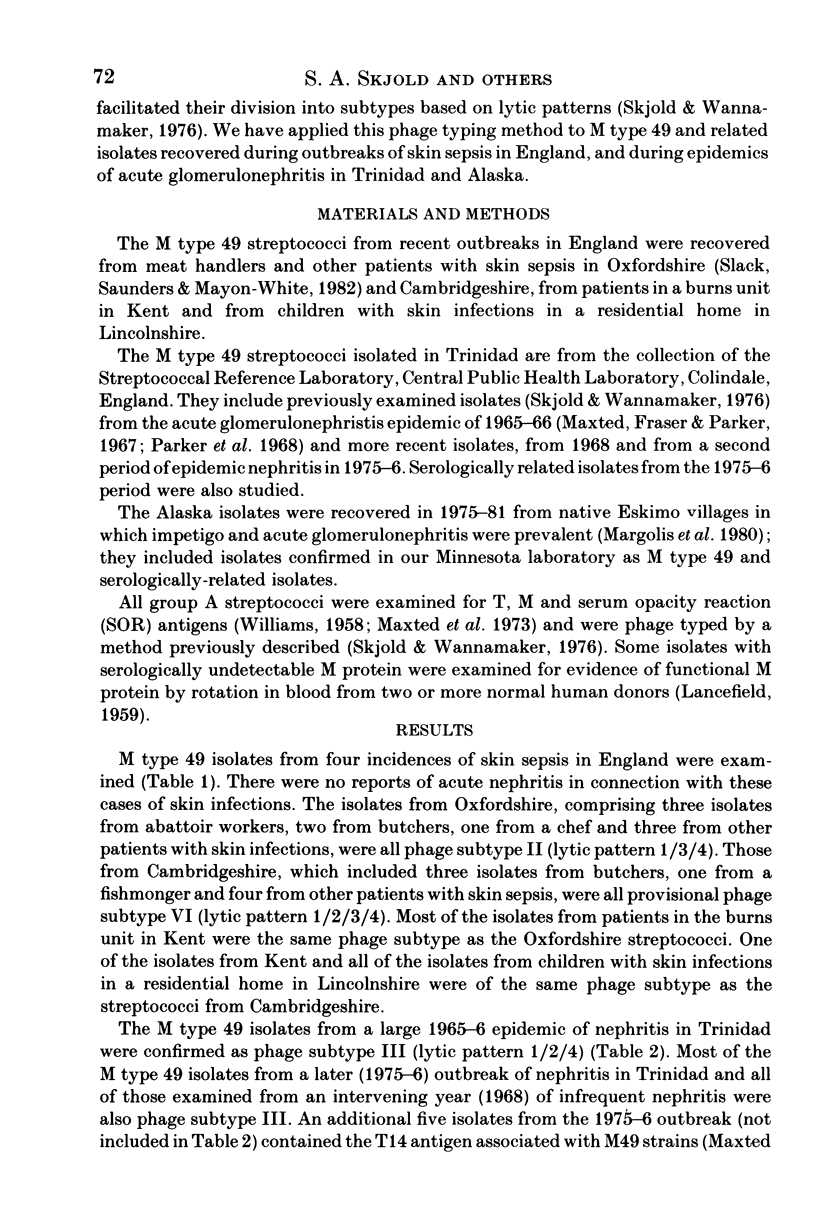Abstract
Studies of group A, M type 49 streptococci from England, Trinidad and Alaska indicate that isolates of this serotype often differ with respect to phage subtype from one geographical area to another, but are generally homogeneous in one place at one time. The findings support the conclusion that acute glomerulonephritis can be associated with a variety of phage subtypes of M type 49 streptococci. In outbreaks of skin sepsis without nephritis in England, the phage subtypes of M type 49 streptococci isolated from skin lesions of meat handlers were the same as those recovered from skin lesions of non-meat handlers in the same community. The findings on the Trinidad isolates suggest that M type 49 streptococci of one phage subtype may persist in a population for 9 years and may result in a second outbreak of acute glomerulonephritis. In an Alaska Eskimo population in whom acute glomerulonephritis was occurring, most of the M type 49 isolates available for testing were of a single phage subtype. Equally prevalent in this population were group A streptococci that exhibited the same T antigen as the type 49 isolates but differed in their serum opacity reaction and phage subtype. This apparently related strain was not typable with available M antisera but showed functional evidence of M protein and is probably a new M type.
Full text
PDF





Selected References
These references are in PubMed. This may not be the complete list of references from this article.
- Dillon H. C., Derrick C. W., Dillon M. S. M-antigens common to pyoderma and acute glomerulonephritis. J Infect Dis. 1974 Sep;130(3):257–267. doi: 10.1093/infdis/130.3.257. [DOI] [PubMed] [Google Scholar]
- Dillon H. C., Jr, Moody M. D., Maxted W. R., Parker M. T. The epidemiology of impetigo and acute glomerulonephritis. Results of serological typing of group A streptococci. Am J Epidemiol. 1967 Nov;86(3):710–723. doi: 10.1093/oxfordjournals.aje.a120779. [DOI] [PubMed] [Google Scholar]
- Fraser C. A., Ball L. C., Morris C. A., Noah N. D. Serological characterization of group-A streptococci associated with skin sepsis in meat handlers. J Hyg (Lond) 1977 Apr;78(2):283–296. doi: 10.1017/s0022172400056175. [DOI] [PMC free article] [PubMed] [Google Scholar]
- LANCEFIELD R. C. Persistence of type-specific antibodies in man following infection with group A streptococci. J Exp Med. 1959 Aug 1;110(2):271–292. doi: 10.1084/jem.110.2.271. [DOI] [PMC free article] [PubMed] [Google Scholar]
- Margolis H. S., Lum M. K., Bender T. R., Elliott S. L., Fitzgerald M. A., Harpster A. P. Acute glomerulonephritis and streptococcal skin lesions in Eskimo children. Am J Dis Child. 1980 Jul;134(7):681–685. doi: 10.1001/archpedi.1980.02130190049013. [DOI] [PubMed] [Google Scholar]
- Maxted W. R., Fraser C. A., Parker M. T. Streptococcus pyogenes, type 49. A nephritogenic Streptococcus with a wide geographical distribution. Lancet. 1967 Mar 25;1(7491):641–644. doi: 10.1016/s0140-6736(67)92540-8. [DOI] [PubMed] [Google Scholar]
- Maxted W. R., Widdowson J. P., Fraser C. A., Ball L. C., Bassett D. C. The use of the serum opacity reaction in the typing of group-A streptococci. J Med Microbiol. 1973 Feb;6(1):83–90. doi: 10.1099/00222615-6-1-83. [DOI] [PubMed] [Google Scholar]
- Mayon-White R. T., Perks E. M. Why type streptococci? The epidemiology of group A streptococci in Oxfordshire 1976-1980. J Hyg (Lond) 1982 Jun;88(3):439–452. doi: 10.1017/s0022172400070303. [DOI] [PMC free article] [PubMed] [Google Scholar]
- Parker M. T., Bassett D. C., Maxted W. R., Arneaud J. D. Acute glomerulonephritis in Trinidad: serological typing of group A streptococci. J Hyg (Lond) 1968 Dec;66(4):657–675. doi: 10.1017/s0022172400028394. [DOI] [PMC free article] [PubMed] [Google Scholar]
- Rowe B., Frost J. A., Threlfall E. J., Ward L. R. Spread of a multiresistant clone of Salmonella typhimurium phage type 66/122 in South-East Asia and the Middle East. Lancet. 1980 May 17;1(8177):1070–1071. doi: 10.1016/s0140-6736(80)91509-3. [DOI] [PubMed] [Google Scholar]
- Skjold S. A., Wannamaker L. W. Method for phage typing group A type 49 streptococci. J Clin Microbiol. 1976 Sep;4(3):232–238. doi: 10.1128/jcm.4.3.232-238.1976. [DOI] [PMC free article] [PubMed] [Google Scholar]
- UPDYKE E. L., MOORE M. S., CONROY E. Provisional new type of group A streptococci associated with nephritis. Science. 1955 Feb 4;121(3136):171–172. doi: 10.1126/science.121.3136.171. [DOI] [PubMed] [Google Scholar]
- WANNAMAKER L. W., PIERCE H. C. Family outbreak of acute nephritis associated with type 49 streptococcal infection. J Lancet. 1961 Dec;81:561–571. [PubMed] [Google Scholar]
- WILLIAMS R. E. Laboratory diagnosis of streptococcal infections. Bull World Health Organ. 1958;19(1):153–176. [PMC free article] [PubMed] [Google Scholar]


